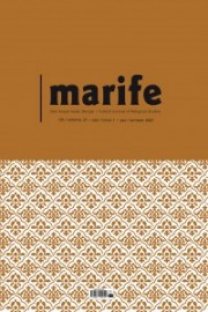Hz. Mevlânâ’nın Eserlerinde Hadis Kültürü
Müslümanın hem maddî hem de manevî hayatını besleyen ayet ve hadisler, İslâmî ilimlerin de temel referansı durumundadır. Bu ilimleri besleyen özellikle hadislerin otantikliği meselesi, kişinin öğrendiği veya yaşadığı İslam’ın keyfiyeti hususunda büyük önem taşımaktadır. Binaenaleyh gelişen ilimlerin sınırları belirginleşmeye başladıktan sonra kullanmış oldukları hadisler de tartışılmaya başlanmıştır. Hz. Peygamber’in vefatından kısa bir süre sonra ilk nüveleri ortaya çıkmaya başlayan, zamanla teşekkül ederek sistemleşen ve İslâmî ilimler içerisinde Müslümanların manevî yaşantısını en fazla konu edinen Tasavvuf ilmi, şüphesiz çok fazla hadise yer vermektedir. Ancak kullandıkları hadisler açısından çeşitli eleştiriler alan Tasavvuf, yer yer haksız tenkitlere maruz kalabilmiştir. Makalede, XIII. asır Selçuklu Anadolu’sunda sûfî kimliği ile öne çıkan ve günümüzde tasavvuf denince ilk akla gelen birkaç isimden biri olan Mevlânâ Celâleddin er-Rûmî’nin eserleri çerçevesinde hadis kullanımı tespit edilmeye çalışılacaktır
Anahtar Kelimeler:
Mevlânâ Celâleddin er-Rûmî, Mesnevî, Tasavvuf, Hadis, Yorum
Hadith Culture in the Works of Mawlana Jalaladdin al-Rumi
Hadith Culture in the Works of Mawlana Jalaladdin al-Rumi Qur’anic verses and hadiths, feeding the spiritual life of Muslims, are also the base refer- ence of Islamic sciences. Especially the authenticity of the hadiths that support these sci- ences has a great importance since they affect the quality of Islamic knowledge and daily experience of Islam. Consequently, after the borders of Islamic sciences established, the authenticity of the hadith quoted by these sciences as evidence became subject to debate. Tasawwuf (Islamic Mysticism) is a science that mainly relates to the spiritual life of Mus- lims. Its first core emerged shortly after the death of the Prophet (pbuh) and became sys- tematic by time. There is no doubt that Tasawwuf commonly refers to hadiths. Although one of the most criticized sciences for its occasional use of hadith, this science has also been subject to unfair criticism. This article tries to determine the use of hadith in the works of Mawlana Jalaladdin al-Rumi, a 13th century Saldjuki Anatolian mystic who is today one of the first names that come to mind when Tasawwuf is mentioned
Keywords:
Mawlana Jalaladdin al-Rumi, Mathnawi, Sufism, Hadith, Comments,
- Yayın Aralığı: Yılda 2 Sayı
- Başlangıç: 31.05.2001
- Yayıncı: Yediveren Kitap
Sayıdaki Diğer Makaleler
Etik Dine Nasıl Dayandırılabilir?
Hz. Mevlânâ’nın Eserlerinde Hadis Kültürü
Vakf-İbtidânın Ayetlerin Anlaşılmasındaki Rolü
Kazakistan’da Kur’an ve Tefsir Literatürü (Kazakça ve Rusça Eserler)
Farabi’nin Medeniyet Tasavvuru ve Kurucu Metni Olarak -İhsâu’l-Ulum- Adlı Eserinin Tahlili
Müşkil Ayetler Bağlamında Zekeriya-Yahya Kıssası
Osmanlı Dönemi Arap Şiirinde Taştîr
